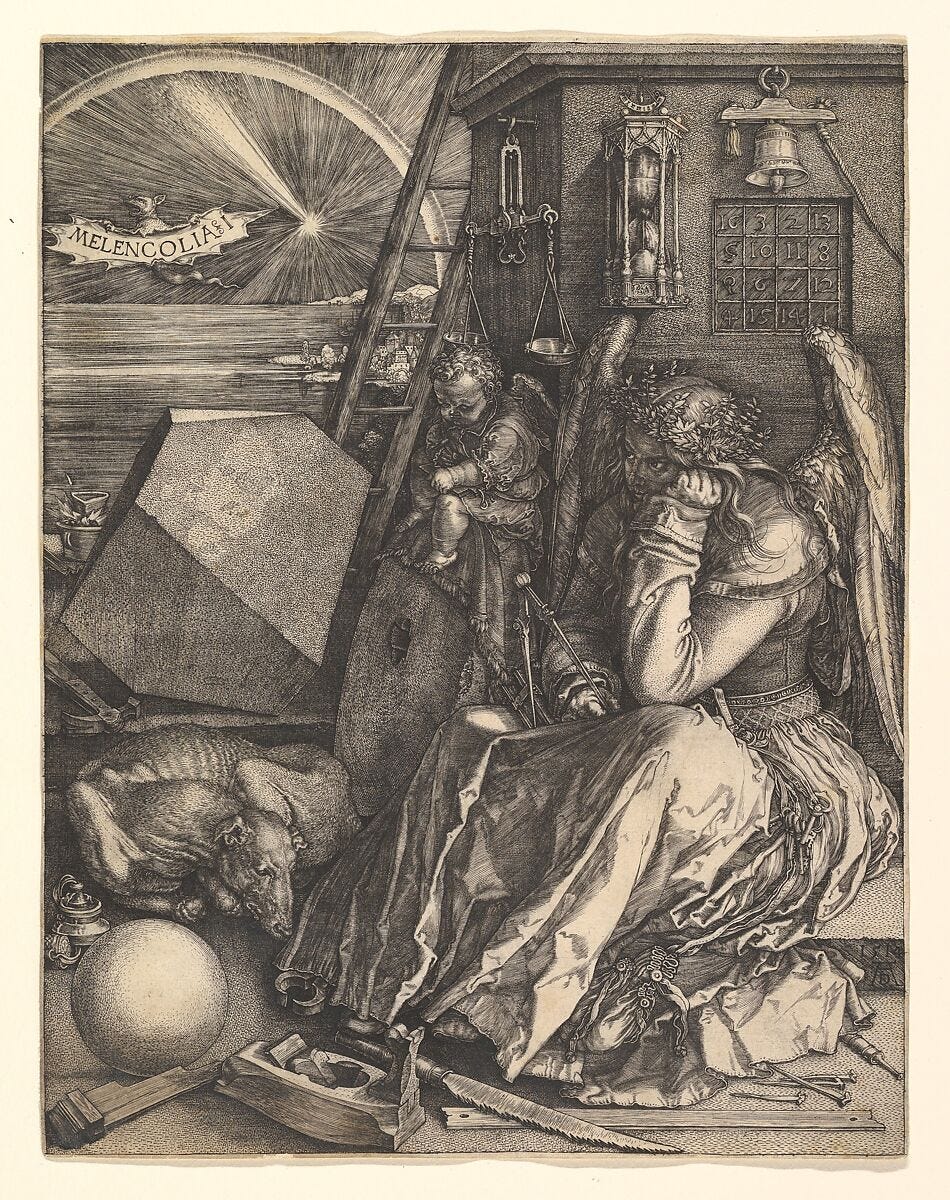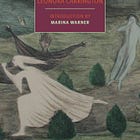Melancholia: Albercht Durer
Outdated diagnoses, traits of melancholic art and the work of one famous artist.
This month I’ve shared with you some outdated mental health terms as they relate to the intersection of art history and psychology. We looked at hysteria and neurasthenia. Well, we can’t leave out melancholia.
What Is Melancholia?
The term "melancholia" has a long and complex history in the field of mental health. Originally used by the ancient Greeks to describe a state of sadness or depression, the term was later adopted by medieval and Renaissance physicians as a diagnostic category for a range of physical and mental symptoms. In the 17th and 18th centuries, the concept of melancholia became more closely associated with the study of the emotions and the psychology of personality.
In the 19th century, melancholia was increasingly recognized as a distinct psychiatric disorder, characterized by persistent feelings of sadness, worthlessness, and hopelessness, as well as physical symptoms such as loss of appetite and insomnia. The German psychiatrist Emil Kraepelin distinguished between "endogenous" and "reactive" forms of melancholia, with the former being seen as a more severe and chronic condition.
Melancholia vs. Depression
The term "melancholia" fell out of favor as a diagnostic category in the mid-20th century, as psychiatrists and psychologists began to adopt more standardized criteria for mental health diagnoses. The symptoms associated with melancholia are now generally included under the broader category of major depressive disorder (MDD) in the Diagnostic and Statistical Manual of Mental Disorders (DSM). (Take diagnosis for what you will, this is what we’re currently using and someday it will be out of date as well.)
In modern psychiatry, the term "melancholia" is not used as a separate diagnostic category, but rather is considered a specifier that can be used to describe a certain type of depression. The diagnostic criteria for major depressive disorder (MDD) in the Diagnostic and Statistical Manual of Mental Disorders (DSM-5) includes a specifier for "melancholic features," which describes a severe form of depression that is characterized by the following symptoms:
Loss of pleasure in almost all activities (anhedonia)
A lack of reactivity to usually pleasurable stimuli
A depressed mood that is distinct from normal sadness
Early morning awakening
Marked psychomotor agitation or retardation
Significant weight loss or loss of appetite
Excessive or inappropriate guilt
In other words, melancholic depression is a specific subtype of depression that is characterized by a particularly severe and persistent set of symptoms. While the terms "melancholia" and "depression" are often used interchangeably, they can refer to different things depending on the context and time period in question.
Melancholic Art vs. Melancholia
Melancholic as a descriptive term is different, of course, from melancholia as a diagnosis. The melancholic style has been associated with a range of art forms, including literature, music, and visual art, and has been used to describe diverse works including Shakespeare's tragedies, the music of J.S. Bach, and the paintings of Edward Hopper.
Melancholic art is a bit dark, a bit sad, often feauring themes of loss and despair. And it is often associated with the emotional and psychological states of the artist. So, while melancholic art and melancholia are distinct concepts, they are often related in that many artists who have created melancholic art have also experienced melancholic or depressive states of mind. The relationship between art and mental health is complex and multifaceted, and the expression of sadness and melancholy in art is just one of the many ways in which artists have sought to explore and understand their own emotional and psychological experiences.
Albrecht Durer: Melancholia
This is an excerpt from my book, The Artist’s Mind: The Creative Lives and Mental Health of Famous Artists
Albrecht Durer created a powerful engraving named Melancholia that some have suggested is a self-portrait of his own depression. In Durer’s time, people still followed medical ideas based on The Four Humors, a Greek idea from Hippocratic medicine relating different symptoms (such as phlegm) with different illnesses and temperaments. We don’t have to get into all of the old medicine here but the argument goes that the spleen was ultimately linked with melancholy and that Durer both drew and mentioned his spleen several times throughout his life, perhaps in an effort to try to get doctors to pay attention to his depression.
In particular, he created a painting called The Sick Durer, a self-portrait pointing to his yellowed spleen. This followed on the heels of a decade of stressors, including watching his father die. Within the next two years, his godfather and mother both died as well. Grief can turn into depression when not properly processed. That brings us to the Melencolia I etching. The name itself clues us in to the topic. Dark features, slouched posture, and the inclusion of symbols that represent depression all help drive the point home. And this takes us back to the Greeks because Melancholia itself was one of the four humors - associated with cold, dry qualities, black bile, and depression - but also with creativity and art. This reflects that the historical diagnosis was closely linked with physical symptoms; we recognize this in depression today but in an entirely different way. (Of course, there are varied belief systems and approaches to medicine, so some modern care providers do look at things like the spleen and phlegm to diagnose mental health conditions, but overwhelmingly Western medicine no longer takes this approach, for better or worse.)
And melancholy itself was viewed through different lenses. Researcher Jane Kromm, writing about Michelangelo shares,
“The melancholic character, originally one of the four humors and aligned over the years with the planet Saturn, altered in meaning during the late Middle Ages and Renaissance. In post-medieval poetry, melancholy became associated less with medical usage and increasingly with an emphasis on a subjective and transitory mood (Panofsky et al. 1964:218). By the beginning of the Renaissance, this transitory nature was allied with a brooding withdrawal from reality. The heightened self-awareness that such a condition implied was tinged with the romantic connotation afforded a tragic hero. Moreover, melancholia came to be seen as an attractive condition.”
This emphasizes that how individuals saw their symptoms, because of or in spite of their diagnoses, has a lot to do with interpretations of both mental health and artistic impulse over time. If you have symptoms like dark thoughts and trouble eating and sleeping, you might see those symptoms as unbearable examples of your psychological flaws or you might see them “as an attractive condition” for your artistic output. Your experience will have as much to do with the time in which you live and the professionals whom you see as it does with the symptoms themselves.
If you read this far, perhaps you liked the work. The work does take work. It only continues with support, so please consider subscribing. My annual rate starts at $10 per year.









So interesting! I love that something that is used as a diagnosis is also used to describe a particular style. Makes me wonder what other similar concepts are out there that serve this double duty!
The term “melancholia” as a diagnosis always reminds me of Abraham Lincoln—I’ve read that this was a defining feature and driving force of his leadership.
Really interesting read. I hadn’t realised that Durer lived as recently as 20th-century. His art style seems so much older - very apt that you included a reference to Michaelangelo, as that’s more the period that Durer’s work feels like it should come from to me. (The Sick Durer, that you included here is very reminiscent of Leonardo Da Vinci’s drawings, for example.)